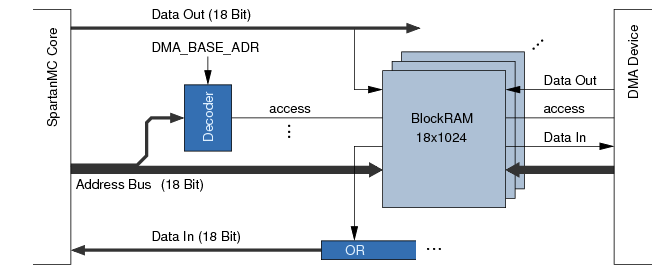DMA Model
DMA Approach
Memory Blocks on FPGAs are generally dual ported. Due to
this fact, we are able to connect one port of the memory
block to the peripheral while the other port is connected
to the SpartanMC address and data bus. The peripheral can
now use the memory to its own liking (even with a different
clock domain).
Schematic of the SpartanMC DMA Model integration
The processor still has arbitrary access to the DMA memory
through data accesses. Typically, this is used for peripherals
which have to work autonomously on large data volumes. Another
possibility is to use that memory as a kind of mailbox system,
where the processor writes commands (leading to action from
the peripheral controller) or reading status information.
Asynchronous activation of the processor is done with an
interrupt signal. Also, the peripheral can monitor the
accesses to the DMA memory to check for new commands, once
the processor changed particular addresses. Alternatively,
the peripheral controller can continuously monitor the
memory cells that hold commands and start working as soon
as a valid change is detected.

It should be mentioned that this concept has two drawbacks:
Firstly, it only works with internal memory of the FPGA.
Secondly, each memory block can only be used by one DMA
capable peripheral. Thus, it is not possible to exchange data
by one DMA capable peripheral to an other without using the
processors core.